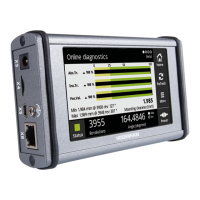December 2001 Configuration of Interfaces 8 – 17
n Data input from EXT to TNC
When the receiving buffer is full, the TNC removes the RTS signal. This is
detected by the peripheral device at its CTS input:
The DTR and DSR signals indicate the operational status of the TNC and
peripheral device:
n DTR: Interrogated by peripheral; it is logical one if TNC is ready for service.
n DSR: Interrogated by TNC.
• HIGH level means: external data input/output ready.
• LOW level means: external data input/output not ready.
Software
handshaking
With bit 3 you determine whether the TNC stops transfer from an external
device with control character <DC3>. Transfer is then resumed with character
<DC1>. (XON/XOFF method)
If transfer is stopped with the control character <DC3>, up to three more
characters can be stored; any further incoming characters are lost. Software
handshake is normally recommended when interfaces are connected to an
external device.
Character parity Bits 4 and 5 determine the type of parity check.
C
T
R
T
RxD
TxD
RST
CST
TxD
RxD
+
TNC
+
+
+
+
+
+
+
EXT
Input buffer
full
+ positive voltage level
negative voltage level
Start
Note
The TNC reacts both to hardware and software handshakes, regardless
of the setting in MP5020.x.
If no transmission stop is set in MP5020.x, the TNC stops the peripheral
unit with the software handshake.
If a transmission stop by RTS and by DC3 is active simultaneously,
the TNC stops transfer with the hardware handshake.

